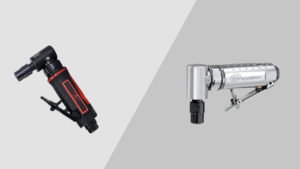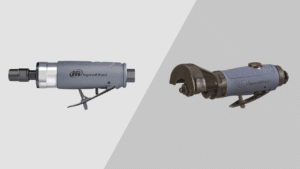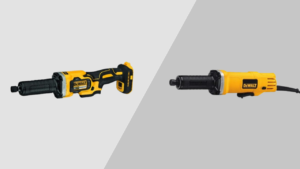
Table of Contents
Are you in the market for a new die grinder? The Ingersoll Rand 3101G and the Ingersoll Rand 301B are two excellent options to consider. These die grinders are designed to deliver exceptional performance, but which one should you choose? In this review, we will analyze these tools based on their power, durability, ergonomics, and versatility. Whether you’re a professional or a DIY enthusiast, having the right die grinder tool with the appropriate speeds can greatly impact your projects. So let’s dive into the unique features of these tools to help you make an informed decision.
If you’re looking for more detailed information, these individual guides might be useful:
Comparison
 Ingersoll Rand 3101G |
Winner
 Ingersoll Rand 301B | |
|---|---|---|
| Horsepower | 0.33 HP | 0.25 HP |
| Power Source | Air Powered | Air Powered |
| Maximum Rotational Speed | 20,000 RPM | 21,000 RPM |
| Dimensions | 9.5 x 6 x 2 inches | 5.27 x 1.34 x 2.91 inches |
| Weight | 1.3 pounds | 1.02 pounds |
| Output | 1/4″ | 1/4″ |
| Exhaust | Rear | Front |
| Material | Composite | Metal |
Power Source and Horsepower
Ingersoll Rand 3101G
The Ingersoll Rand 3101G is a super cool tool that works with compressed air. This die grinder has a motor with a power of 0.33 HP. Just hook it up to an air compressor and watch it go.
Ingersoll Rand 301B
The Ingersoll Rand 301B also operates using compressed air, but is equipped with a slightly lower power motor at 0.25 HP (0.19k-Watt).
Both tools are designed to be efficient for various applications, but the difference in horsepower and cfm might affect their performance in heavier-duty tasks.
Winner: Ingersoll Rand 3101G
- With more HP, Ingersoll Rand 3101G is a clear winner here.
Design and Dimensions
Ingersoll Rand 3101G
The Ingersoll Rand 3101G is a right angle tool that has dimensions of 9.5 x 6 x 2 inches. With its larger size, it offers a comfortable grip that reduces vibrations and increases overall comfort during use. It is perfect for heavy-duty tasks and comes with a rear exhaust.
Ingersoll Rand 301B
In contrast, the Ingersoll Rand 301B boasts a more compact design with dimensions of 5.27 x 1.34 x 2.91 inches and an aluminum housing that withstands tough operating conditions. The compact size allows easy access to tight spots where larger tools may not reach, providing versatility in its usage scenarios. Additionally, the front exhaust ensures that your work surface remains clean while you’re working.
Winner: Ingersoll Rand 301B
- The 301B is the better choice because it has a front exhaust and is lightweight, compact, and tough.
Weight and Portability
Both models are engineered with a focus on portability, ensuring that users can handle them with minimal effort. Although both are lightweight, the Ingersoll Rand 301B edges out slightly lighter than the 3101G, providing an advantage in terms of reduced physical strain during prolonged usage.
Winner: Ingersoll Rand 301B
Performance and Speed
Ingersoll Rand 3101G
The Ingersoll Rand 3101G features a maximum rotational speed of 20,000 RPM. This air die grinder is powered by compressed air with a 1/3 HP motor, providing high-speed performance for various applications. It also incorporates a self-locking throttle for precise control during operation.
Ingersoll Rand 301B
In contrast, the Ingersoll Rand 3101G has a maximum rotational speed of 21,000 RPM, which is slightly lower than the Ingersoll Rand 301B. It is equipped with a strong motor and precise gearing, allowing it to deliver exceptional performance and efficiency as an air die grinder. To ensure safety, it features an integrated self-locking throttle lever that prevents any accidental start-ups.
Winner: Ingersoll Rand 301B
- The 301B model edges ahead by providing just a little more RPM to come out on top.
Construction and Durability
Ingersoll Rand 3101G
The Ingersoll Rand 3101G is designed with ball bearing construction, ensuring ruggedness and durability, making it suitable for heavy-duty applications. Its pneumatic-powered operation guarantees reliable performance in various working conditions. Its lightweight nature enhances maneuverability without compromising on sturdiness.
Ingersoll Rand 301B
Similarly, the Ingersoll Rand 301B incorporates durable ball-bearing construction that not only improves balance but also reduces vibration during operation. The strong aluminum housing further reinforces its ability to withstand tough operating conditions while maintaining a lightweight design for easy handling in tight spaces.
Winner: Ingersoll Rand 301B
- The 301Bs’ metal construction gets the advantage here.
Maintenance and Lubrication
Ingersoll Rand 3101G
The Ingersoll Rand 3101G air die grinder is equipped with a grease fitting hole, allowing for easy lubrication. This feature contributes to increased gear life, ensuring the tool’s longevity and optimal performance.
Ingersoll Rand 301B
In contrast, the Ingersoll Rand 301B air die grinder requires regular maintenance and lubrication to maintain its optimal performance level. The absence of built-in lubrication features necessitates periodic attention to ensure smooth functioning.
Winner: Ingersoll Rand 3101G
- The 3101G offers convenient options for keeping the tool well-lubricated while also enhancing its durability.
Included Components and Special Features
Ingersoll Rand 3101G
The Ingersoll Rand 3101G comes as a bare-tool without additional components.
Ingersoll Rand 301B
The package comes with one 301B Air Angle Die Grinder, along with 1/4-inch and 6 mm collets, as well as two wrenches.
Winner: Ingersoll Rand 301B
Safety Features
The Ingersoll Rand 3101G and the Ingersoll Rand 301B are both designed to prioritize user safety. They have self-locking throttles that prevent accidental start-ups, ensuring peace of mind and minimizing the risk of accidents during use. These models take extra precautions to avoid accidental start-ups by incorporating their own self-locking throttle systems. This important safety feature safeguards users from potential harm when operating these tools.
Winner: even
Buying Guide
When considering the Ingersoll Rand 3101G vs Ingersoll Rand 301B, it’s crucial to match the power source and horsepower with your specific needs. The 3101G boasts a pneumatic-powered source with a 0.33 HP motor, while the 301B features a slightly lower power of 0.25 HP.
Evaluate the design and dimensions to ensure it fits your intended use; the compact build of both models allows for easy handling in tight spaces. However, if lightweight is a priority, the 301B weighs only 1.02 pounds compared to the 1.3-pound weight of the 3101G.
Portability is essential for ease of use and transportation; both models are designed with this in mind due to their lightweight construction and ergonomic grips that reduce vibration and increase comfort during prolonged use.
Assessing performance and speed is crucial; while both models offer impressive speeds, reaching up to approximately 21,000 RPM, you should consider your individual requirements when making this comparison.
Construction and durability play significant roles in long-lasting performance; both models feature ball-bearing construction for ruggedness and durability alongside strong aluminum housing or sturdy composite materials that withstand tough operating conditions.
Customer reviews and reports
Ingersoll Rand 3101G
Customers appreciate the Ingersoll Rand 3101G for its powerful performance despite being lightweight. The pneumatic-powered design, ergonomic grip to reduce vibration, and ball bearing construction for ruggedness have received positive feedback. Users find the grease fitting hole for easy lubrication and increased gear life to be a valuable feature.
Ingersoll Rand 301B
The Ingersoll Rand 301B has garnered praise from customers for its durable ball-bearing construction that provides improved balance and reduced vibration. Its lightweight design allows easy operation and access to tight spots, which users find advantageous. The integral self-locking throttle lever for safety has been positively reviewed.
Conclusion
Now that you have a detailed comparison of the Ingersoll Rand 3101G vs Ingersoll Rand 301B, including their power source, design, performance, and construction, it’s time to think about which factors are most important for your specific needs. Whether you value portability, speed, or durability, the right choice depends on what matters most to you in your everyday work.
With that in mind, here is my choice. The Ingersoll Rand 301B is my preferred choice due to its compact size and lightweight design. It has the ability to reach a maximum speed of 21,000 RPM, which is why it stands out as the clear winner for me.
Happy grinding!
Frequently Asked Questions
Is the Ingersoll Rand 3101G or 301B more suitable for tight spaces and easy operation?
The Ingersoll Rand 301B is a better option for working in tight spots due to its lightweight design and compact dimensions. It offers easier maneuverability, making it ideal for intricate tasks.
Which air die grinder provides better durability, the Ingersoll Rand 3101G or the 301B?
Both models have a tough build and ball bearing construction that improves their strength and lifespan. However, the 301B, which is made of metal, comes out on top in terms of durability.
What are the differences in terms of safety features between the Ingersoll Rand 3101G and the 301B?
Both the Ingersoll Rand 3101G and the 301B are designed with user safety as a top priority. They come equipped with self-locking throttles to prevent any accidental start-ups, giving users peace of mind and reducing the chances of accidents occurring during operation.



